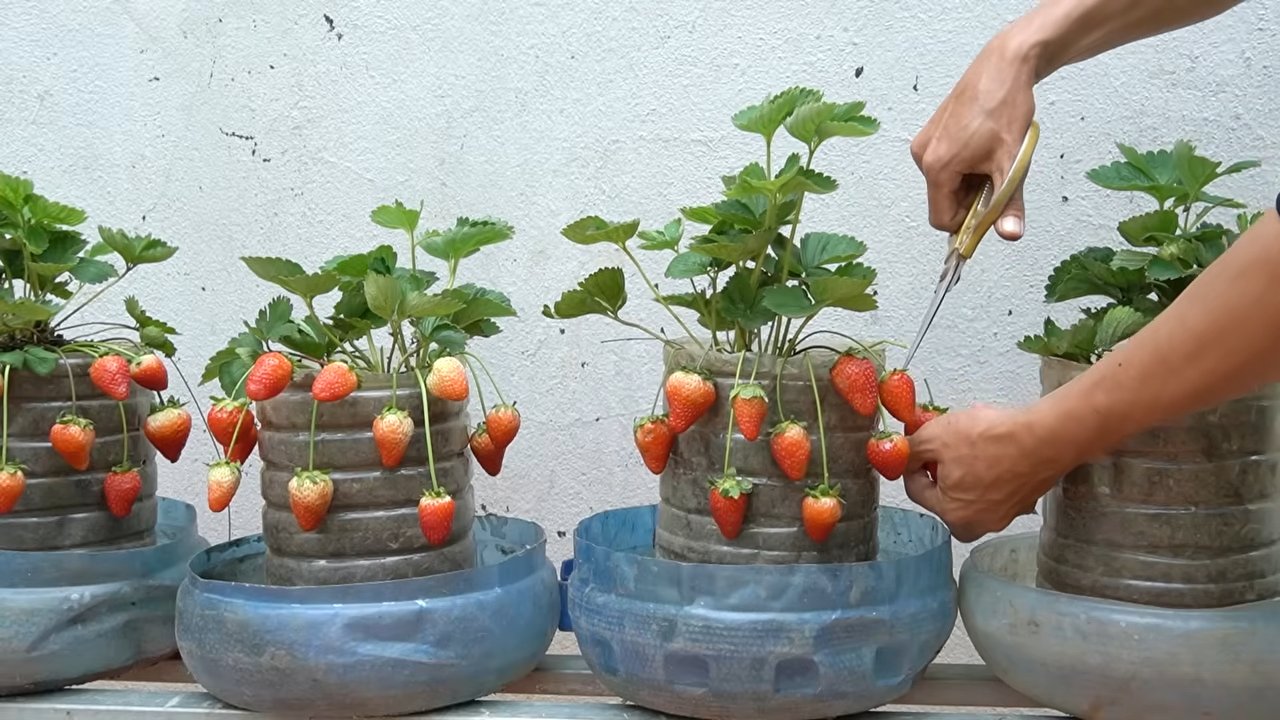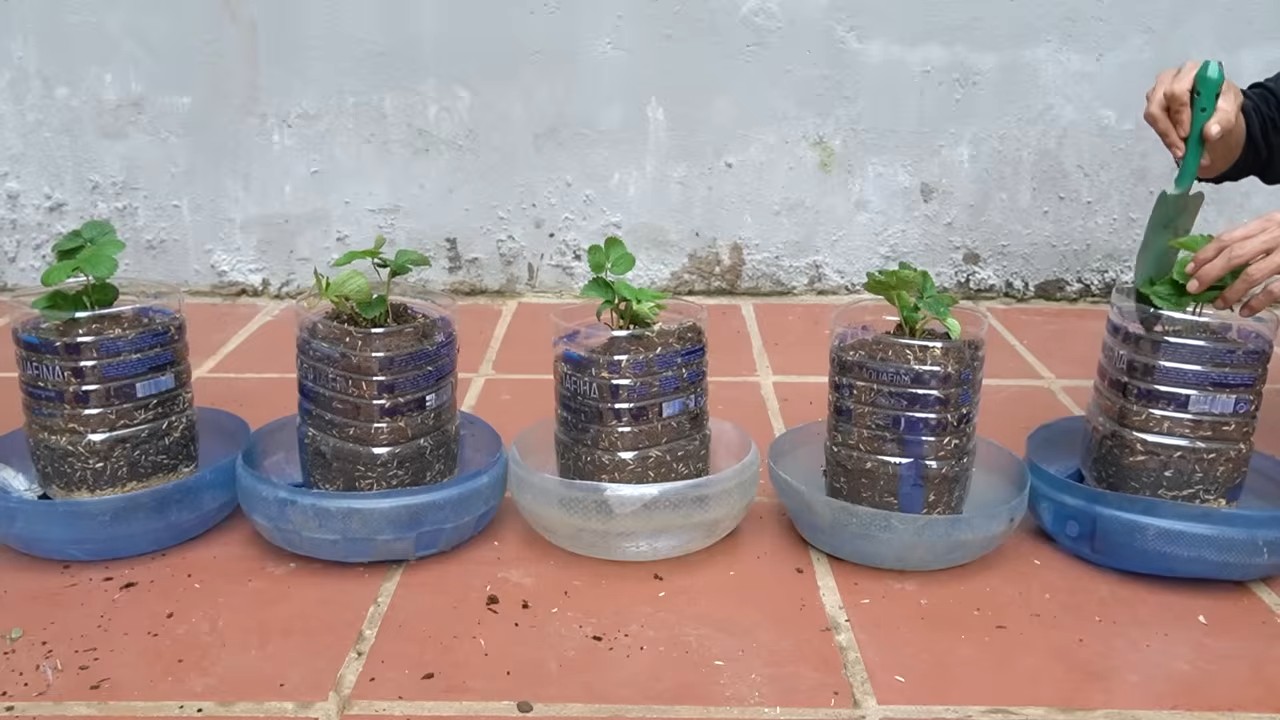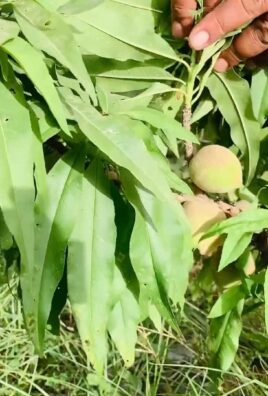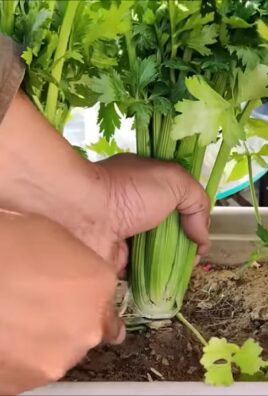Strawberry Growing Tips: Who doesn’t love the taste of a sun-ripened, juicy strawberry, bursting with flavor straight from the garden? Imagine stepping outside your back door and picking a handful of these ruby-red gems whenever you crave a sweet treat. It’s not just a dream; it’s an achievable reality with the right knowledge and a little bit of elbow grease! For centuries, strawberries have been cultivated and enjoyed, with evidence suggesting their presence in ancient Roman gardens. From wild berries foraged in forests to the carefully bred varieties we know today, strawberries hold a special place in our hearts (and stomachs!).
But let’s be honest, sometimes growing these delectable fruits can feel a bit tricky. Pests, diseases, and even just knowing where to start can be overwhelming. That’s where these DIY strawberry growing tips come in! I’m going to share some of my favorite hacks and tricks that will help you cultivate a thriving strawberry patch, no matter your experience level. Whether you’re a seasoned gardener or a complete beginner, these simple yet effective techniques will empower you to grow an abundance of delicious strawberries right at home. Get ready to transform your garden into a strawberry paradise!

DIY Strawberry Paradise: From Tiny Seed to Berry Bonanza!
Hey there, fellow garden enthusiasts! I’m so excited to share my tried-and-true methods for growing the juiciest, most delicious strawberries you’ve ever tasted. Forget those bland, store-bought berries – we’re talking about homegrown goodness bursting with flavor. This guide is packed with tips and tricks I’ve learned over the years, so get ready to transform your garden (or even your balcony!) into a strawberry paradise.
Choosing the Right Strawberry Variety
Before we even think about planting, it’s crucial to pick the right strawberry variety for your climate and preferences. There are three main types:
* June-Bearing: These produce one large crop of strawberries, usually in late spring or early summer. They’re great if you want a big harvest for jams and freezing.
* Everbearing: As the name suggests, these produce strawberries throughout the growing season, with peaks in spring and fall. They’re perfect for continuous snacking!
* Day-Neutral: Similar to everbearing, day-neutral varieties produce fruit throughout the growing season, regardless of day length. They’re a good choice for warmer climates.
Consider your local climate and how much space you have. Some varieties are more compact than others. I personally love everbearing varieties because I can enjoy fresh strawberries all summer long!
Preparing Your Strawberry Patch
Strawberries need a sunny spot and well-drained soil to thrive. Here’s how to get your patch ready:
* Sunlight: Aim for at least 6-8 hours of direct sunlight per day. The more sun, the sweeter the berries!
* Soil: Strawberries prefer slightly acidic soil with a pH between 5.5 and 6.5.
* Drainage: Good drainage is essential to prevent root rot. If your soil is heavy clay, amend it with compost, peat moss, or other organic matter.
* Weed Control: Clear the area of all weeds before planting. Weeds compete with strawberries for nutrients and water.
Planting Your Strawberry Plants
Now for the fun part – planting! You can start strawberries from seeds, bare-root plants, or potted plants. I usually opt for bare-root or potted plants because they’re easier to establish.
Step-by-Step Planting Guide:
1. Soak Bare-Root Plants: If you’re using bare-root plants, soak the roots in water for about an hour before planting. This helps rehydrate them.
2. Dig Holes: Dig holes that are large enough to accommodate the roots of your plants without crowding them. Space the plants about 12-18 inches apart in rows that are 2-3 feet apart.
3. Planting Depth: This is crucial! Make sure the crown of the plant (where the roots meet the stem) is level with the soil surface. Planting too deep can cause the crown to rot, while planting too shallow can dry out the roots.
4. Spread the Roots: Gently spread the roots out in the hole before backfilling with soil.
5. Water Thoroughly: Water the plants thoroughly after planting to settle the soil and help them establish.
6. Mulch: Apply a layer of mulch around the plants to help retain moisture, suppress weeds, and keep the berries clean. Straw is a classic choice, but you can also use wood chips or pine needles.
Caring for Your Strawberry Plants
Once your strawberry plants are in the ground, it’s important to provide them with the care they need to thrive.
* Watering: Water regularly, especially during dry spells. Strawberries need consistent moisture to produce juicy berries. Aim for about 1 inch of water per week. Drip irrigation is a great way to deliver water directly to the roots.
* Fertilizing: Fertilize your strawberry plants in early spring and again after the first harvest. Use a balanced fertilizer that’s specifically formulated for berries. Avoid over-fertilizing, as this can lead to excessive foliage growth and fewer berries.
* Weed Control: Keep the area around your strawberry plants free of weeds. Hand-pulling is the best option, as herbicides can damage the plants.
* Pest and Disease Control: Keep an eye out for common strawberry pests and diseases, such as slugs, snails, aphids, and fungal diseases. Use organic pest control methods whenever possible. I’ve found that diatomaceous earth is effective against slugs and snails.
* Renovating June-Bearing Plants: After the harvest, mow the foliage down to about 1 inch above the crown. This helps rejuvenate the plants and encourages new growth. Thin out the plants to maintain good spacing.
* Removing Runners: Strawberry plants produce runners, which are stems that grow horizontally and develop new plantlets. If you want to maximize berry production, remove the runners. However, if you want to propagate new plants, you can allow the runners to root.
Protecting Your Strawberry Patch
Strawberries are a favorite snack for birds, squirrels, and other critters. Here are some ways to protect your precious berries:
* Netting: Cover your strawberry patch with netting to keep birds and squirrels away. Make sure the netting is securely anchored to the ground to prevent animals from getting underneath.
* Row Covers: Use row covers to protect your plants from frost and pests. Row covers are lightweight fabric covers that are placed over the plants.
* Scarecrows: A scarecrow can help deter birds and other animals.
* Companion Planting: Plant herbs like basil, thyme, and rosemary near your strawberries to repel pests.
Harvesting Your Strawberries
The moment you’ve been waiting for – harvesting! Strawberries are usually ready to harvest about 30 days after flowering.
* Ripeness: Look for berries that are fully red and slightly soft to the touch.
* Harvesting Technique: Gently twist or cut the stem just above the berry. Avoid pulling the berries, as this can damage the plant.
* Timing: Harvest strawberries in the morning, after the dew has dried.
* Storage: Store unwashed strawberries in the refrigerator for up to a week. Wash them just before eating.
Growing Strawberries in Containers
Don’t have a garden? No problem! You can easily grow strawberries in containers.
* Container Size: Choose a container that’s at least 12 inches in diameter and 8 inches deep.
* Potting Mix: Use a high-quality potting mix that’s well-draining.
* Planting: Plant the strawberries in the container, following the same planting guidelines as for in-ground planting.
* Watering and Fertilizing: Water and fertilize the plants regularly. Container-grown strawberries tend to dry out more quickly than those grown in the ground.
* Sunlight: Place the container in a sunny location.
* Overwintering: In cold climates, you’ll need to protect your container-grown strawberries from freezing temperatures. You can move the containers to a sheltered location, such as a garage or shed, or wrap them in burlap.
Propagating New Strawberry Plants
Want to expand your strawberry patch without buying new plants? You can easily propagate new plants from runners.
1. Allow Runners to Root: Allow the runners to root in small pots filled with potting mix.
2. Separate the Plantlets: Once the plantlets have developed roots, separate them from the mother plant.
3. Plant the New Plants: Plant the new plants in the garden or in containers.
Troubleshooting Common Strawberry Problems
Even with the best care, you may encounter some problems when growing strawberries. Here are some common issues and how to address them:
* Small Berries: Small berries can be caused by insufficient sunlight, poor soil, or lack of water. Make sure your plants are getting enough sun, amend the soil with compost, and water regularly.
* Rotting Berries: Rotting berries can be caused by fungal diseases or excessive moisture. Improve air circulation around the plants by thinning out the foliage. Avoid overhead watering.
* Pest Infestations: Keep an eye out for common strawberry pests, such as slugs, snails, aphids, and spider mites. Use organic pest control methods to manage infestations.
* Leaf Spot: Leaf spot is a fungal disease that causes brown spots on the leaves. Remove infected leaves and apply a fungicide if necessary.
Strawberry Varieties I Recommend
Over the years, I’ve experimented with many different strawberry varieties. Here are a few of my favorites:
* Albion: An everbearing variety that produces large, sweet berries.
* Seascape: Another excellent everbearing variety with good disease resistance.
* Honeoye: A June-bearing variety that’s known for its high yields and excellent flavor.
* Ozark Beauty: A June-bearing variety that produces large, juicy berries.
Making

Conclusion
So, there you have it! Mastering these simple yet effective DIY strawberry growing tips can transform your backyard into a berry bonanza. Forget those bland, store-bought strawberries that lack the vibrant flavor and juicy sweetness of homegrown goodness. By implementing these techniques, you’re not just growing strawberries; you’re cultivating an experience – a connection to nature, a source of pride, and a delicious reward for your efforts.
The beauty of these DIY methods lies in their accessibility. You don’t need a sprawling farm or expensive equipment to enjoy a bountiful harvest. Whether you’re a seasoned gardener or a complete beginner, these tips are designed to be easy to understand and implement. From optimizing your soil to protecting your precious plants from pests, each step is a building block towards strawberry success.
But don’t just take our word for it. The real magic happens when you put these tips into practice. Imagine biting into a sun-ripened strawberry, bursting with flavor, knowing that you nurtured it from a tiny seedling to a delectable treat. That’s the power of DIY strawberry growing.
Ready to take your strawberry game to the next level?
Consider these variations to personalize your strawberry growing experience:
* **Vertical Strawberry Gardens:** If space is limited, explore vertical gardening options. Hanging baskets, stacked planters, or even repurposed pallets can create a stunning and productive strawberry display.
* **Companion Planting:** Enhance your strawberry patch by incorporating companion plants like basil, thyme, or marigolds. These beneficial herbs and flowers can deter pests, attract pollinators, and improve the overall health of your strawberry plants.
* **Strawberry Varieties:** Experiment with different strawberry varieties to discover your favorites. From everbearing strawberries that produce fruit throughout the season to June-bearing varieties that offer a concentrated harvest, there’s a strawberry for every palate and growing condition.
* **Hydroponic Strawberries:** For the adventurous gardener, consider growing strawberries hydroponically. This soilless method can be highly efficient and allows for precise control over nutrient delivery.
We encourage you to embrace the DIY spirit and embark on your own strawberry growing adventure. Don’t be afraid to experiment, adapt these tips to your specific environment, and most importantly, have fun!
Once you’ve reaped the rewards of your labor, we’d love to hear about your experience. Share your photos, tips, and stories in the comments below. Let’s create a community of strawberry enthusiasts who are passionate about growing their own delicious berries. Your insights could inspire others to embark on their own DIY strawberry growing journey. Happy growing!
Frequently Asked Questions (FAQ)
What is the best time of year to plant strawberries?
The ideal time to plant strawberries depends on your climate and the type of strawberry you’re growing. In general, early spring or late fall are the best times. Spring planting allows the plants to establish themselves before the heat of summer, while fall planting gives them a head start for the following spring. For June-bearing varieties, spring planting is often preferred. Everbearing and day-neutral varieties can be planted in either spring or fall. Consider your local climate and consult with your local nursery for specific recommendations.
How much sunlight do strawberries need?
Strawberries thrive in full sun, requiring at least 6-8 hours of direct sunlight per day. Insufficient sunlight can lead to reduced fruit production and smaller, less flavorful berries. Choose a planting location that receives ample sunlight throughout the day. If you live in a particularly hot climate, some afternoon shade may be beneficial to prevent scorching.
What type of soil is best for growing strawberries?
Strawberries prefer well-drained, slightly acidic soil with a pH between 5.5 and 6.5. Amend heavy clay soil with compost or other organic matter to improve drainage. Sandy soil may need amendments to improve water retention. A soil test can help you determine the pH and nutrient levels of your soil and guide you in making necessary amendments.
How often should I water my strawberry plants?
Water your strawberry plants regularly, especially during dry periods. Aim to keep the soil consistently moist but not waterlogged. Overwatering can lead to root rot, while underwatering can stress the plants and reduce fruit production. Water deeply and less frequently, rather than shallowly and more often. Mulching around the plants can help retain moisture and suppress weeds.
What are some common strawberry pests and diseases?
Common strawberry pests include aphids, spider mites, slugs, and birds. Diseases include gray mold, leaf spot, and root rot. Regularly inspect your plants for signs of pests or diseases. Use organic pest control methods such as insecticidal soap or neem oil to control pests. Ensure good air circulation around the plants to prevent fungal diseases. Remove any infected leaves or fruit promptly. Bird netting can protect your berries from hungry birds.
How do I fertilize my strawberry plants?
Fertilize your strawberry plants in early spring and again after the first harvest. Use a balanced fertilizer specifically formulated for berries. Avoid over-fertilizing, as this can lead to excessive foliage growth at the expense of fruit production. Follow the instructions on the fertilizer label carefully. You can also amend the soil with compost or other organic matter to provide a slow-release source of nutrients.
How do I prune my strawberry plants?
Pruning strawberries involves removing runners, dead leaves, and spent fruit. Runners are the stems that the plants send out to propagate. Removing runners encourages the plant to focus its energy on fruit production. Dead leaves and spent fruit should be removed to prevent the spread of disease. After the harvest, you can mow or trim the foliage to rejuvenate the plants.
How long does it take for strawberry plants to produce fruit?
The time it takes for strawberry plants to produce fruit depends on the variety and the planting time. June-bearing varieties typically produce fruit the following spring after planting. Everbearing and day-neutral varieties may produce some fruit in the first year, but the main harvest will be in the second year. Be patient and provide your plants with proper care, and you’ll be rewarded with a bountiful harvest.
Can I grow strawberries in containers?
Yes, strawberries can be successfully grown in containers. Choose a container that is at least 12 inches in diameter and has good drainage. Use a high-quality potting mix and provide the plants with plenty of sunlight and water. Container-grown strawberries may need more frequent watering and fertilization than those grown in the ground.
How do I overwinter my strawberry plants?
In cold climates, strawberry plants need protection during the winter. Mulch around the plants with straw or leaves to insulate the roots. You can also cover the plants with a row cover or cold frame. In very cold climates, you may need to move container-grown strawberries to a sheltered location, such as a garage or shed. Remove the mulch in the spring when the weather warms up.




Leave a Comment